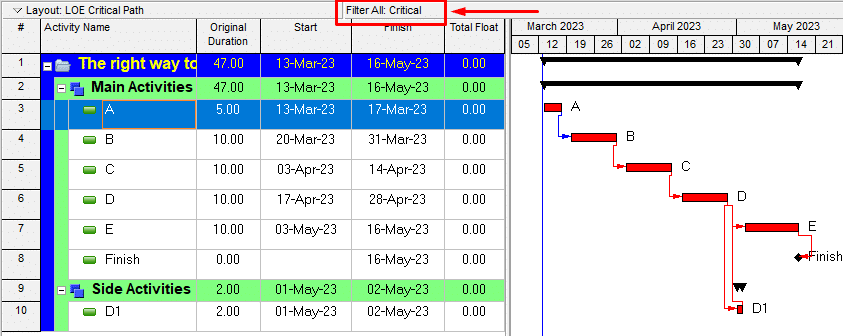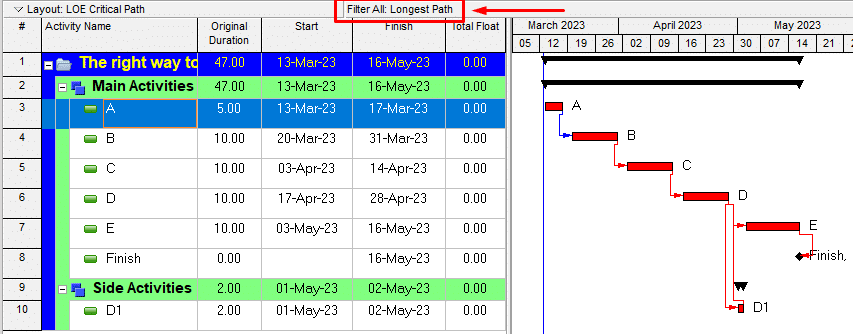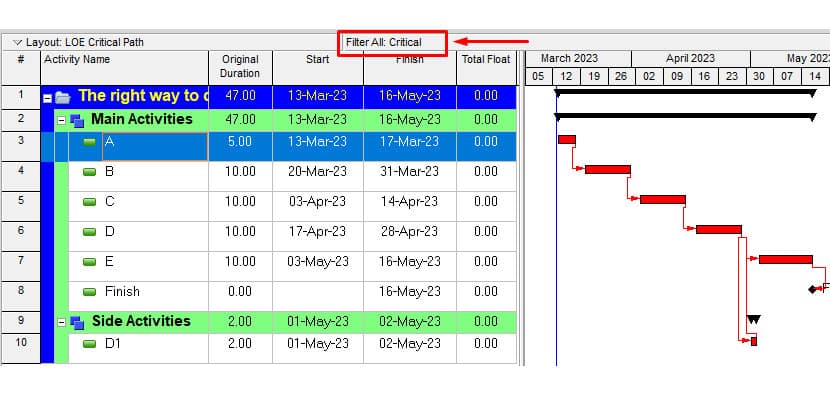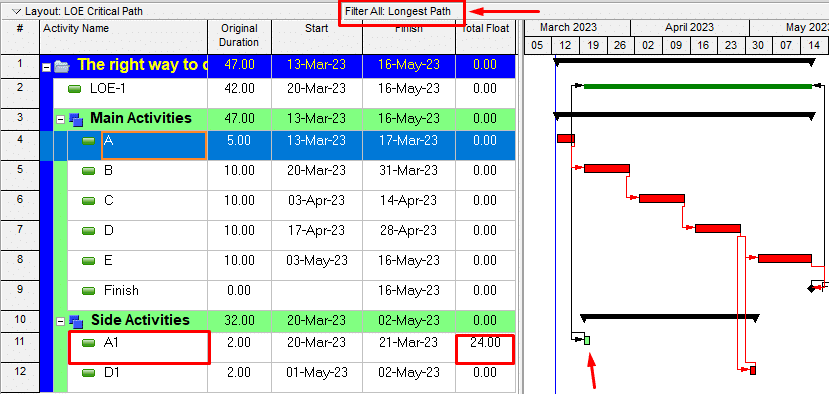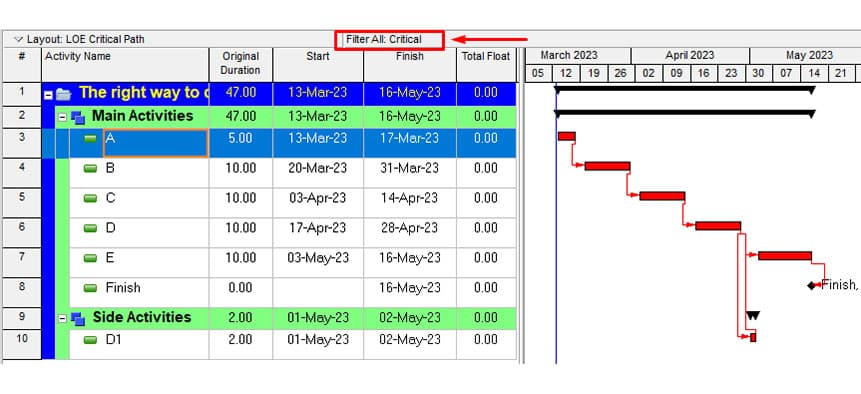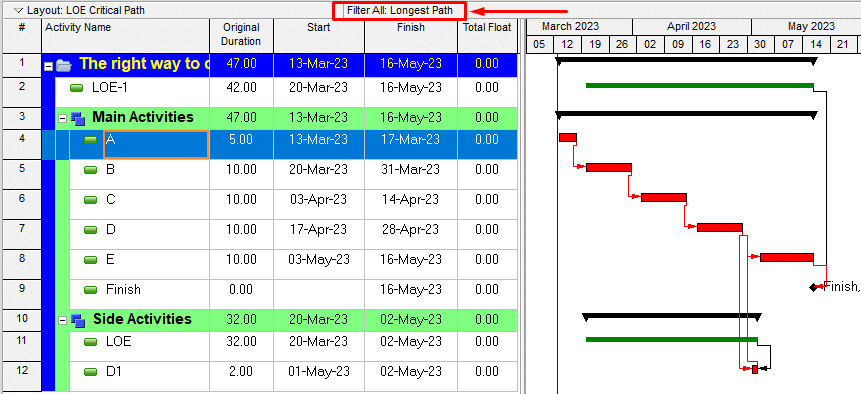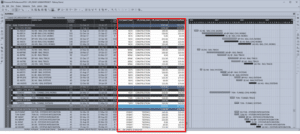Mehdi Takabi
What is the correct way to define the relationships of a Level of Effort (LOE) activity in the P6?
According to the Oracle documents, a level of effort activity’s duration depends on its predecessors/successors. This type of activity is for ongoing tasks, and its duration is calculated based on the earliest start and latest finish of its predecessors/successors, respectively. Therefore, some points need to be taken into consideration when using the LOE activity in the schedule:
- You can assign the calendar to an LOE activity. The assigned calendar overrules the calendars of the activities they are linked to. For instance, if the LOE calendar goes to 4:00 pm, but its driving successor goes to 5:00 pm, the LOE will only schedule to 4:00 pm regardless of the successor activity calendar.
- You cannot assign constraints to an LOE activity.
- LOEs are not included in the resource levelling.
- Although you can assign a duration type to an LOE activity, such as Fixed Duration and Units/Time or Fixed Duration and Units, the duration is never fixed because the activities control the duration the LOE is linked to. This is very important to know, especially when assigning resources to the LOEs.
- Any relationship (SS, FS, FF, SF) can be assigned to an LOE.
There are three (3) common methods to define the relationships of an LOE. However, each way could negatively affect different schedule aspects like the ‘Total Float’ calculation and ‘Longest Path’ or trigger the warning section of the ‘Schedule Log’ report. Therefore, this article will demonstrate these ways and their impacts on the schedule.
The first method many P6 schedulers are familiar with is defining the Start-to-Start (SS) relationship with the first activity linked to the LOE as predecessor and Finish-to-Finish (FF) relationship with the last activity. In the below schedule sample, for the LOE activity whose duration depends on the chain of A-B-C, activity ‘A’ has been assigned as the predecessor of the LOE with SS relationship type, and activity ‘C’ has been assigned as the successor of the LOE with FF relationship type.
Although this method of relationship definition for the LOE activity may seem correct, it could lead to the wrong Longest Path in the schedule.
Imagine we have a chain of activities A-B-C-D-E and a Finish milestone with the FS relationship. Another chain of side activities A1-B1-C1-D1 must be completed before the final activity ‘E’. An LOE has been defined and added to the schedule for these side activities.
For this simple schedule, the Critical Path (based on the total float) should be identical to the Critical Path based on the ‘Longest Path’. But as the pictures below show, this is not the case; we have Activity A1 with TF=24 in the Longest Path 1.


Tom Boyle explained this issue in detail (Boyle, 2017) and recommended using predecessor-only or successor-only relationships to avoid the problem. These are the other two methods of defining the LOE relationships, but they need particular attention as they might bring some drawbacks.
In the predecessor-only relationship method, all the relationships for the LOE activity are assigned using only the ‘Predecessor’ tab. Back to the previous schedule example, both activities of ‘A1’ and ‘D1’ have been assigned in the ‘Predecessor’ tab with SS and FF relationship. As the pictures below show, although the problem is resolved, it triggers the ‘Activities without successors’ warning of the ‘Schedule Log’ report and puts the LOE activity under this category.


This method will not resolve the Longest Path problem if an LOE activity is linked to the project finish date. In the below schedule, the ‘LOE-1’ activity is tied to activities A1 and the Finish milestone using the predecessor-only method. As it shows, the Longest Path contains Activity A1 with TF=24.
Tom Boyle (Boyle, 2017) finally recommended using the successor-only method to avoid the problem. In this method, all the relationships for the LOE activity are assigned using only the ‘Successor’ tab. Back to the previous schedule example, both activities of ‘A1’ and ‘D1’ have been defined in the ‘Successor’ tab with SS and FF relationship.
As the pictures below show, although the incompatibility problem between Longest Path and Critical Path for both scenarios is resolved, it triggers the ‘Activities without predecessors’ warning of schedule log report and puts the LOE activity under this category.
Another drawback of this method is that in-progress LOE will create a negative float in the schedule when ‘Start Float’ is selected as the basis of total float calculation. As the picture below shows, the total float of the LOE becomes a negative value because the ‘Late Start’ is smaller than the ‘Early Start’ dates.
If ‘Finish Float’ is selected in the scheduling option for calculating total float, the negative float will disappear because the ‘Late Finish’ is not smaller than the ‘Early Finish’ dates.
Conclusion:
This article has reviewed the three common ways to define the LOE relationship. As explained, each method could impact the schedule negatively. The below table summarizes these methods and their negative impacts on the schedule characteristics.
Schedulers are recommended to consider each method’s negative impacts when constructing LOEs in the schedule.
Footnotes
[1] P6 Automatically removes the LOE activities from the Critical Path filter but due to longest path calculation algorithm does not remove them from the Longest Path. Meanwhile we know that due to nature of the LOEs, they cannot be flagged as critical in the schedule.
References
Boyle, T. (2017, 11 06). The Right Way to Construct Level of Effort (LOE) Activities in Primavera P6. Retrieved from boyleprojectconsulting: https://boyleprojectconsulting.com/tomsblog/2017/11/06/constructing-level-of-effort-loe-activities-in-primavera-p6/



